warning YAMAHA XL 800 2001 Owner's Manual
[x] Cancel search | Manufacturer: YAMAHA, Model Year: 2001, Model line: XL 800, Model: YAMAHA XL 800 2001Pages: 131, PDF Size: 16.51 MB
Page 67 of 131
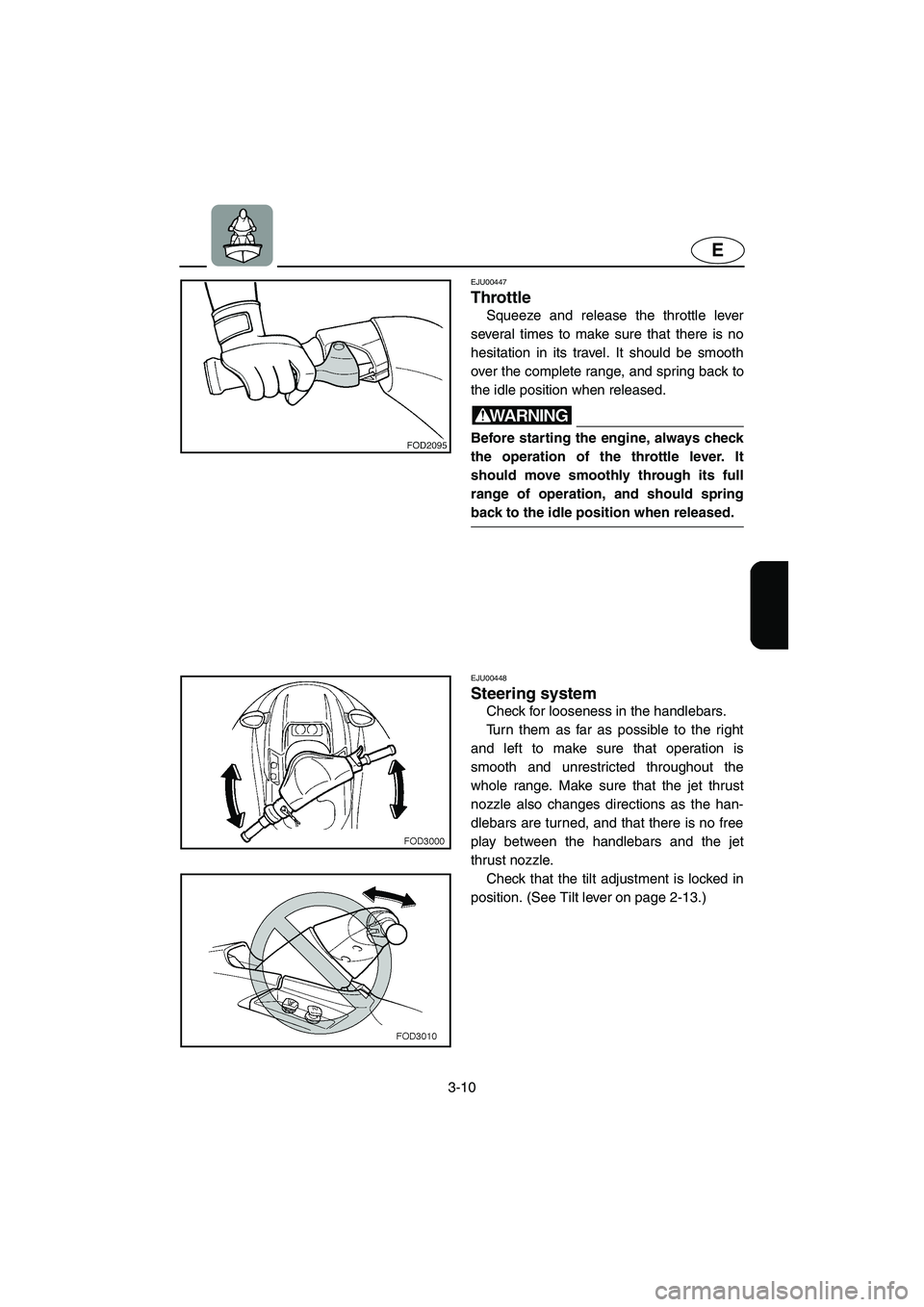
3-10
E
EJU00447
Throttle
Squeeze and release the throttle lever
several times to make sure that there is no
hesitation in its travel. It should be smooth
over the complete range, and spring back to
the idle position when released.
WARNING
Before starting the engine, always check
the operation of the throttle lever. It
should move smoothly through its full
range of operation, and should spring
back to the idle position when released.
EJU00448
Steering system
Check for looseness in the handlebars.
Turn them as far as possible to the right
and left to make sure that operation is
smooth and unrestricted throughout the
whole range. Make sure that the jet thrust
nozzle also changes directions as the han-
dlebars are turned, and that there is no free
play between the handlebars and the jet
thrust nozzle.
Check that the tilt adjustment is locked in
position. (See Tilt lever on page 2-13.)
E_F0P71-3.fm Page 10 Tuesday, July 18, 2000 7:16 PM
Page 68 of 131
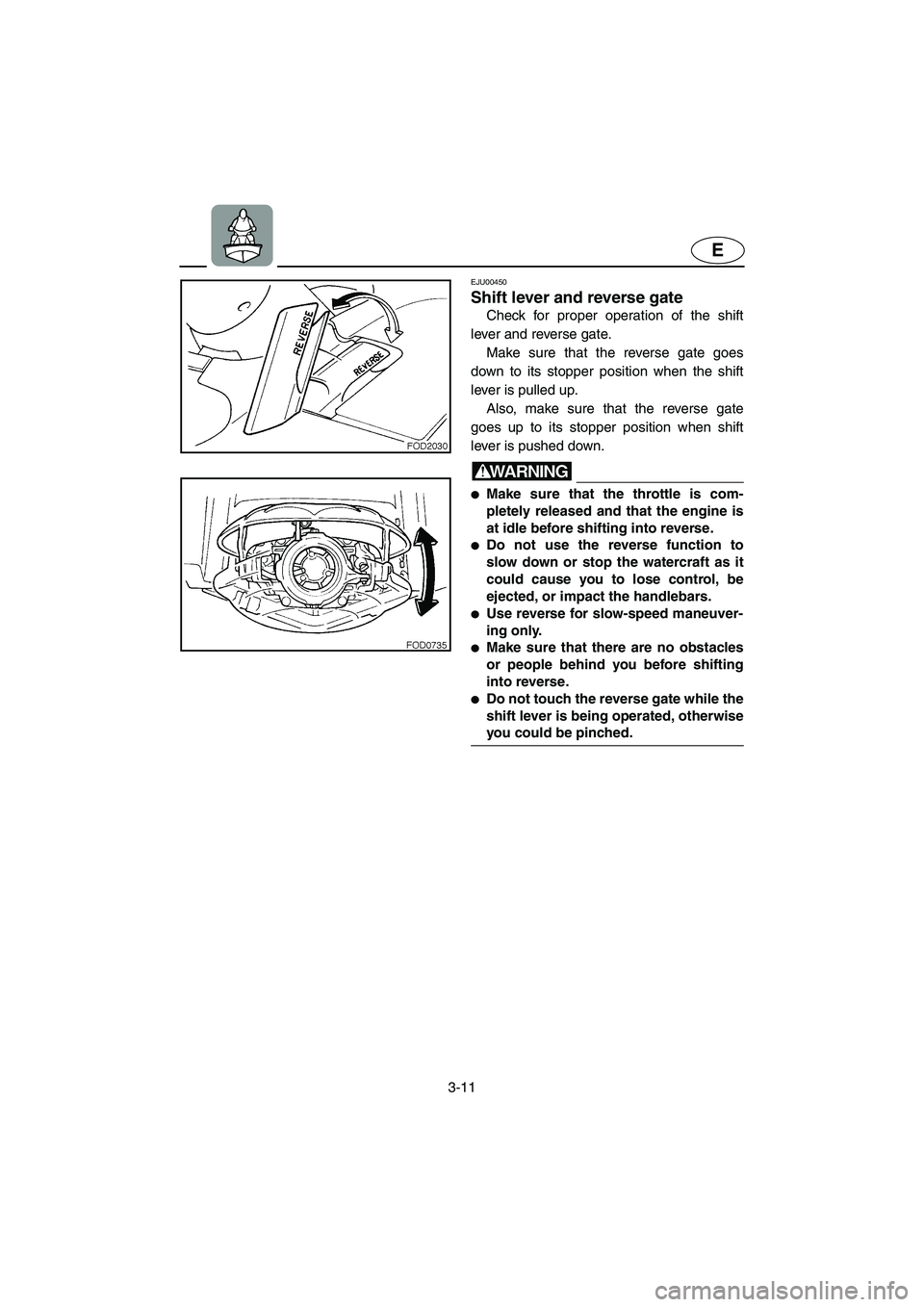
3-11
E
EJU00450
Shift lever and reverse gate
Check for proper operation of the shift
lever and reverse gate.
Make sure that the reverse gate goes
down to its stopper position when the shift
lever is pulled up.
Also, make sure that the reverse gate
goes up to its stopper position when shift
lever is pushed down.
WARNINGJJ●Make sure that the throttle is com-
pletely released and that the engine is
at idle before shifting into reverse.
●Do not use the reverse function to
slow down or stop the watercraft as it
could cause you to lose control, be
ejected, or impact the handlebars.
●Use reverse for slow-speed maneuver-
ing only.
●Make sure that there are no obstacles
or people behind you before shifting
into reverse.
●Do not touch the reverse gate while the
shift lever is being operated, otherwise
you could be pinched.
E_F0P71-3.fm Page 11 Tuesday, July 18, 2000 7:16 PM
Page 69 of 131
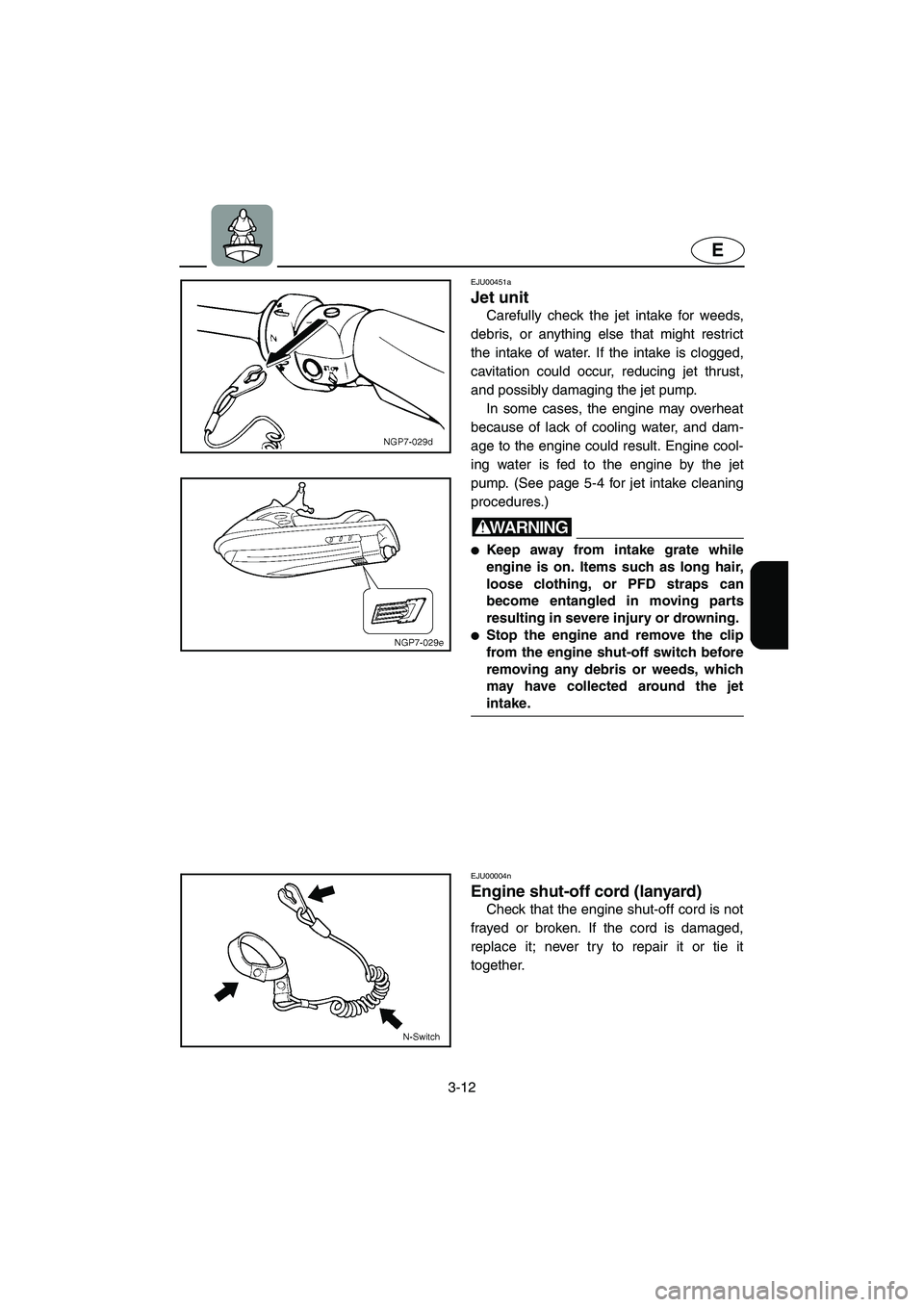
3-12
E
EJU00451a
Jet unit
Carefully check the jet intake for weeds,
debris, or anything else that might restrict
the intake of water. If the intake is clogged,
cavitation could occur, reducing jet thrust,
and possibly damaging the jet pump.
In some cases, the engine may overheat
because of lack of cooling water, and dam-
age to the engine could result. Engine cool-
ing water is fed to the engine by the jet
pump. (See page 5-4 for jet intake cleaning
procedures.)
WARNING
●Keep away from intake grate while
engine is on. Items such as long hair,
loose clothing, or PFD straps can
become entangled in moving parts
resulting in severe injury or drowning.
●Stop the engine and remove the clip
from the engine shut-off switch before
removing any debris or weeds, which
may have collected around the jet
intake.
EJU00004n
Engine shut-off cord (lanyard)
Check that the engine shut-off cord is not
frayed or broken. If the cord is damaged,
replace it; never try to repair it or tie it
together.
E_F0P71-3.fm Page 12 Tuesday, July 18, 2000 7:16 PM
Page 71 of 131
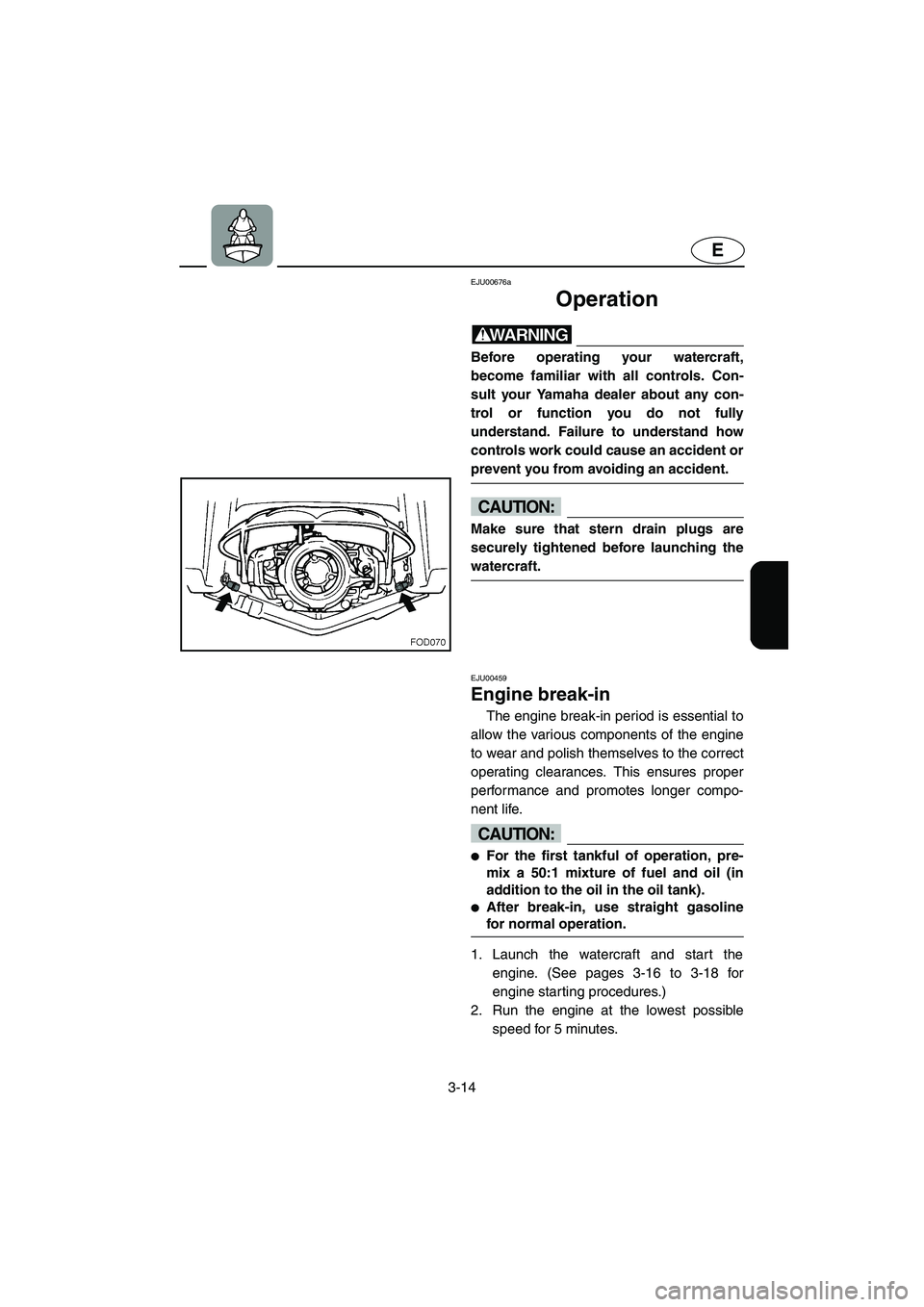
3-14
E
EJU00676a
Operation
WARNING
Before operating your watercraft,
become familiar with all controls. Con-
sult your Yamaha dealer about any con-
trol or function you do not fully
understand. Failure to understand how
controls work could cause an accident or
prevent you from avoiding an accident.
CAUTION:
Make sure that stern drain plugs are
securely tightened before launching the
watercraft.
EJU00459
Engine break-in
The engine break-in period is essential to
allow the various components of the engine
to wear and polish themselves to the correct
operating clearances. This ensures proper
performance and promotes longer compo-
nent life.
CAUTION:
●For the first tankful of operation, pre-
mix a 50:1 mixture of fuel and oil (in
addition to the oil in the oil tank).
●After break-in, use straight gasoline
for normal operation.
1. Launch the watercraft and start the
engine. (See pages 3-16 to 3-18 for
engine starting procedures.)
2. Run the engine at the lowest possible
speed for 5 minutes.
E_F0P71-3.fm Page 14 Tuesday, July 18, 2000 7:16 PM
Page 73 of 131
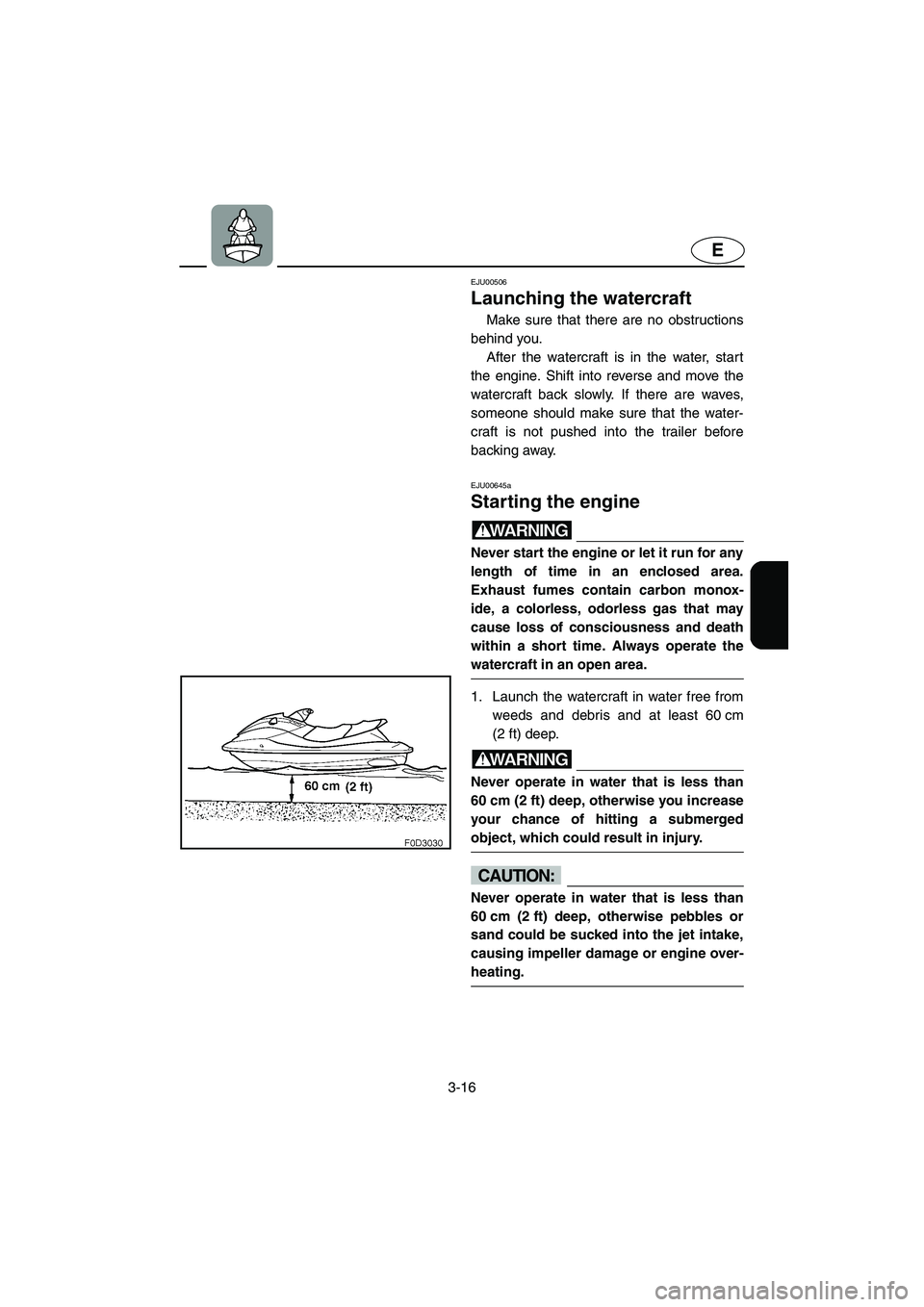
3-16
E
EJU00506
Launching the watercraft
Make sure that there are no obstructions
behind you.
After the watercraft is in the water, start
the engine. Shift into reverse and move the
watercraft back slowly. If there are waves,
someone should make sure that the water-
craft is not pushed into the trailer before
backing away.
EJU00645a
Starting the engine
WARNING
Never start the engine or let it run for any
length of time in an enclosed area.
Exhaust fumes contain carbon monox-
ide, a colorless, odorless gas that may
cause loss of consciousness and death
within a short time. Always operate the
watercraft in an open area.
1. Launch the watercraft in water free from
weeds and debris and at least 60 cm
(2 ft) deep.
WARNING
Never operate in water that is less than
60 cm (2 ft) deep, otherwise you increase
your chance of hitting a submerged
object, which could result in injury.
CAUTION:
Never operate in water that is less than
60 cm (2 ft) deep, otherwise pebbles or
sand could be sucked into the jet intake,
causing impeller damage or engine over-
heating.
E_F0P71-3.fm Page 16 Tuesday, July 18, 2000 7:16 PM
Page 74 of 131
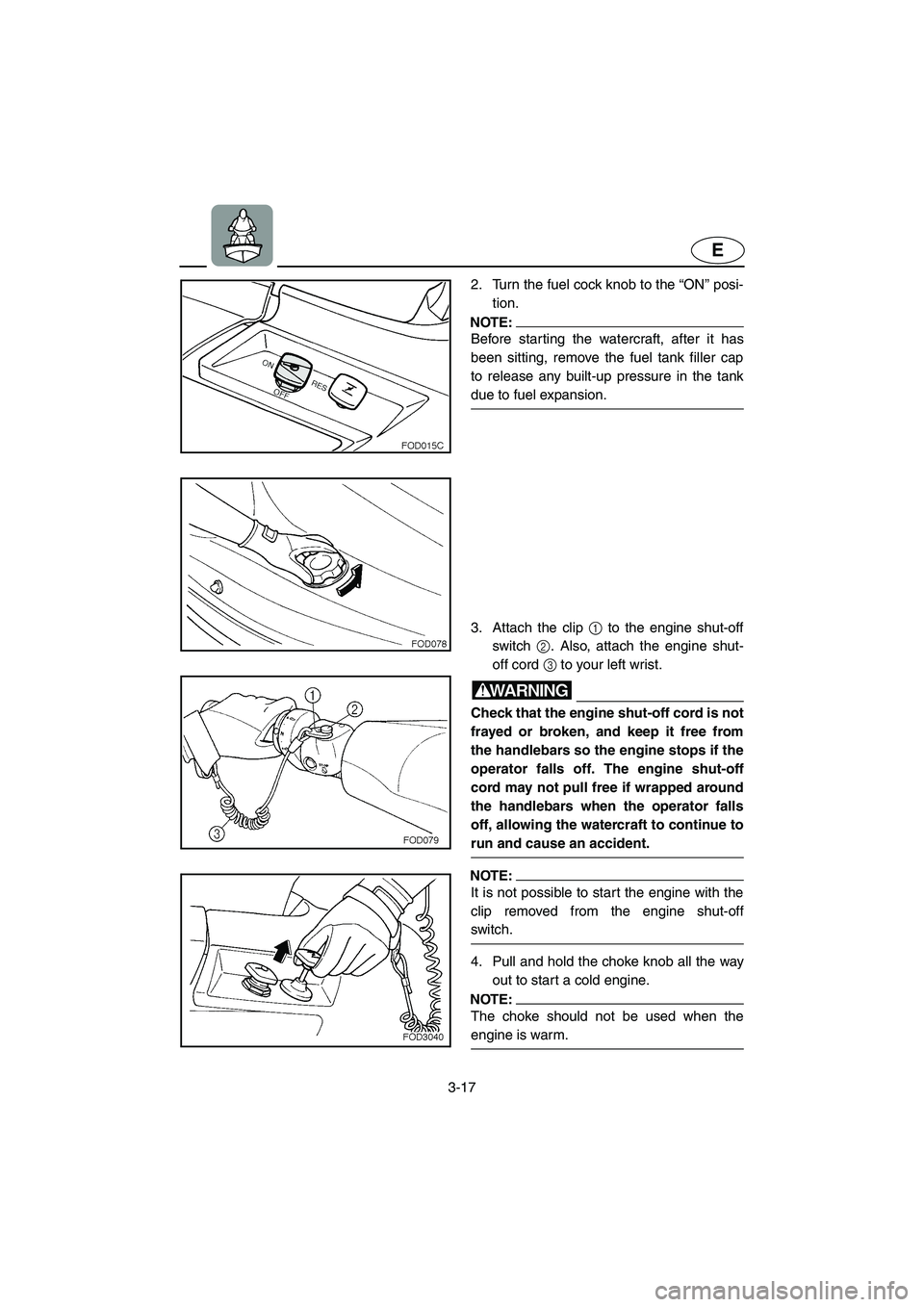
3-17
E
2. Turn the fuel cock knob to the “ON” posi-
tion.
NOTE:
Before starting the watercraft, after it has
been sitting, remove the fuel tank filler cap
to release any built-up pressure in the tank
due to fuel expansion.
3. Attach the clip 1 to the engine shut-off
switch 2. Also, attach the engine shut-
off cord 3 to your left wrist.
WARNING
Check that the engine shut-off cord is not
frayed or broken, and keep it free from
the handlebars so the engine stops if the
operator falls off. The engine shut-off
cord may not pull free if wrapped around
the handlebars when the operator falls
off, allowing the watercraft to continue to
run and cause an accident.
NOTE:
It is not possible to start the engine with the
clip removed from the engine shut-off
switch.
4. Pull and hold the choke knob all the way
out to star t a cold engine.
NOTE:
The choke should not be used when the
engine is warm.
E_F0P71-3.fm Page 17 Tuesday, July 18, 2000 7:16 PM
Page 75 of 131
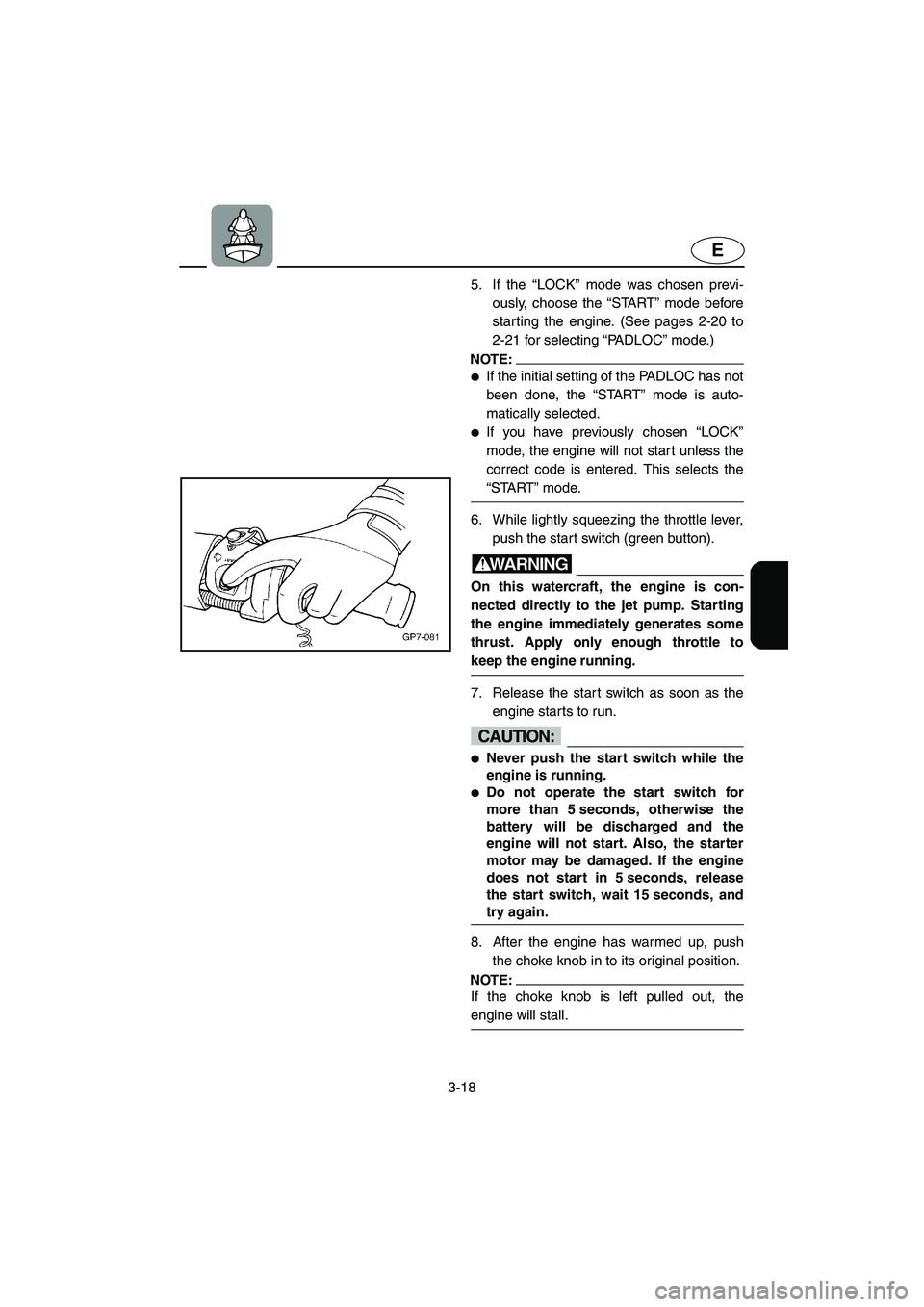
3-18
E
5. If the “LOCK” mode was chosen previ-
ously, choose the “START” mode before
starting the engine. (See pages 2-20 to
2-21 for selecting “PADLOC” mode.)
NOTE:
●If the initial setting of the PADLOC has not
been done, the “START” mode is auto-
matically selected.
●If you have previously chosen “LOCK”
mode, the engine will not start unless the
correct code is entered. This selects the
“START” mode.
6. While lightly squeezing the throttle lever,
push the start switch (green button).
WARNING
On this watercraft, the engine is con-
nected directly to the jet pump. Starting
the engine immediately generates some
thrust. Apply only enough throttle to
keep the engine running.
7. Release the start switch as soon as the
engine starts to run.
CAUTION:
●Never push the start switch while the
engine is running.
●Do not operate the start switch for
more than 5 seconds, otherwise the
battery will be discharged and the
engine will not start. Also, the starter
motor may be damaged. If the engine
does not start in 5 seconds, release
the start switch, wait 15 seconds, and
try again.
8. After the engine has warmed up, push
the choke knob in to its original position.
NOTE:
If the choke knob is left pulled out, the
engine will stall.
E_F0P71-3.fm Page 18 Tuesday, July 18, 2000 7:16 PM
Page 76 of 131
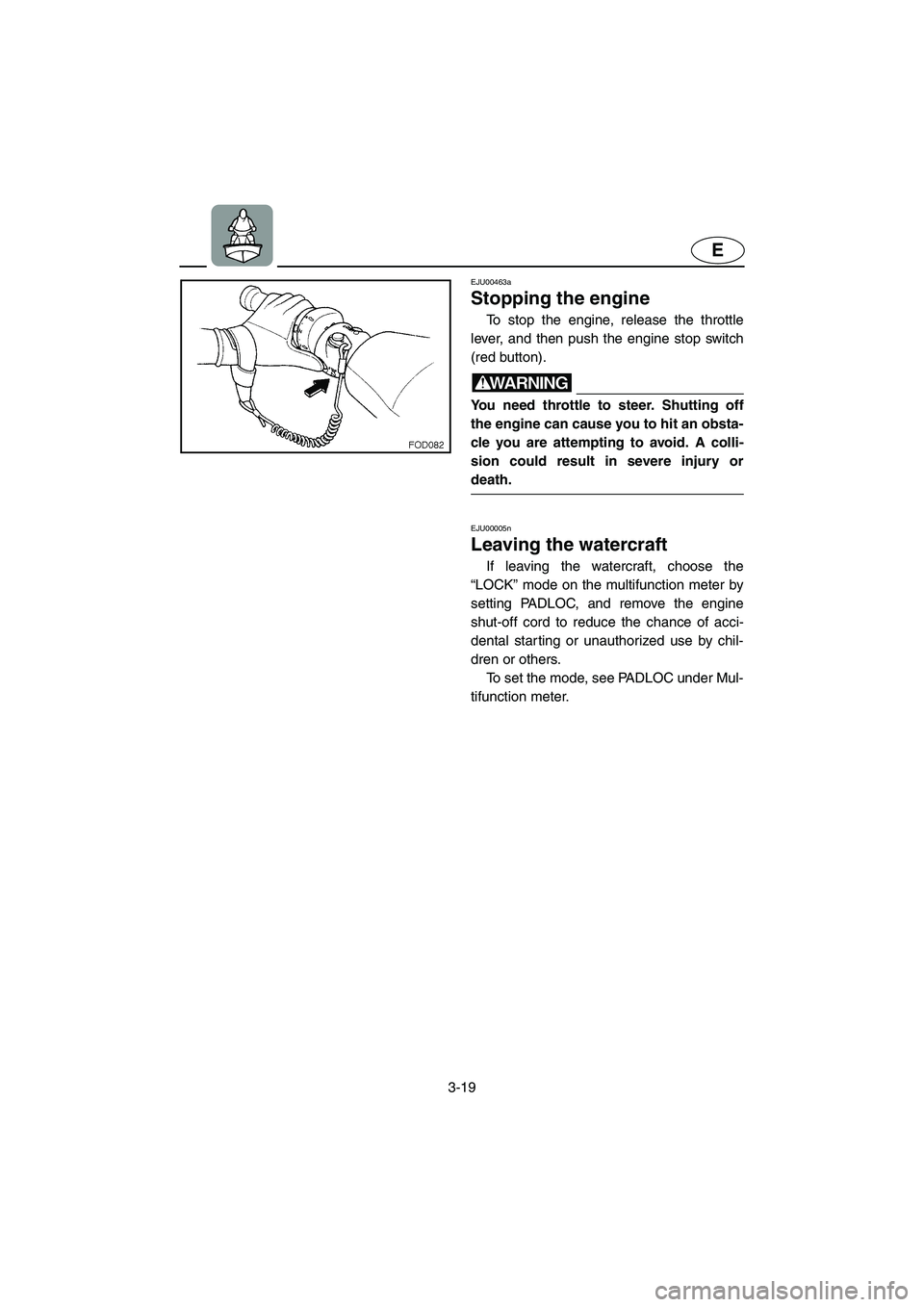
3-19
E
EJU00463a
Stopping the engine
To stop the engine, release the throttle
lever, and then push the engine stop switch
(red button).
WARNING
You need throttle to steer. Shutting off
the engine can cause you to hit an obsta-
cle you are attempting to avoid. A colli-
sion could result in severe injury or
death.
EJU00005n
Leaving the watercraft
If leaving the watercraft, choose the
“LOCK” mode on the multifunction meter by
setting PADLOC, and remove the engine
shut-off cord to reduce the chance of acci-
dental starting or unauthorized use by chil-
dren or others.
To set the mode, see PADLOC under Mul-
tifunction meter.
E_F0P71-3.fm Page 19 Tuesday, July 18, 2000 7:16 PM
Page 77 of 131
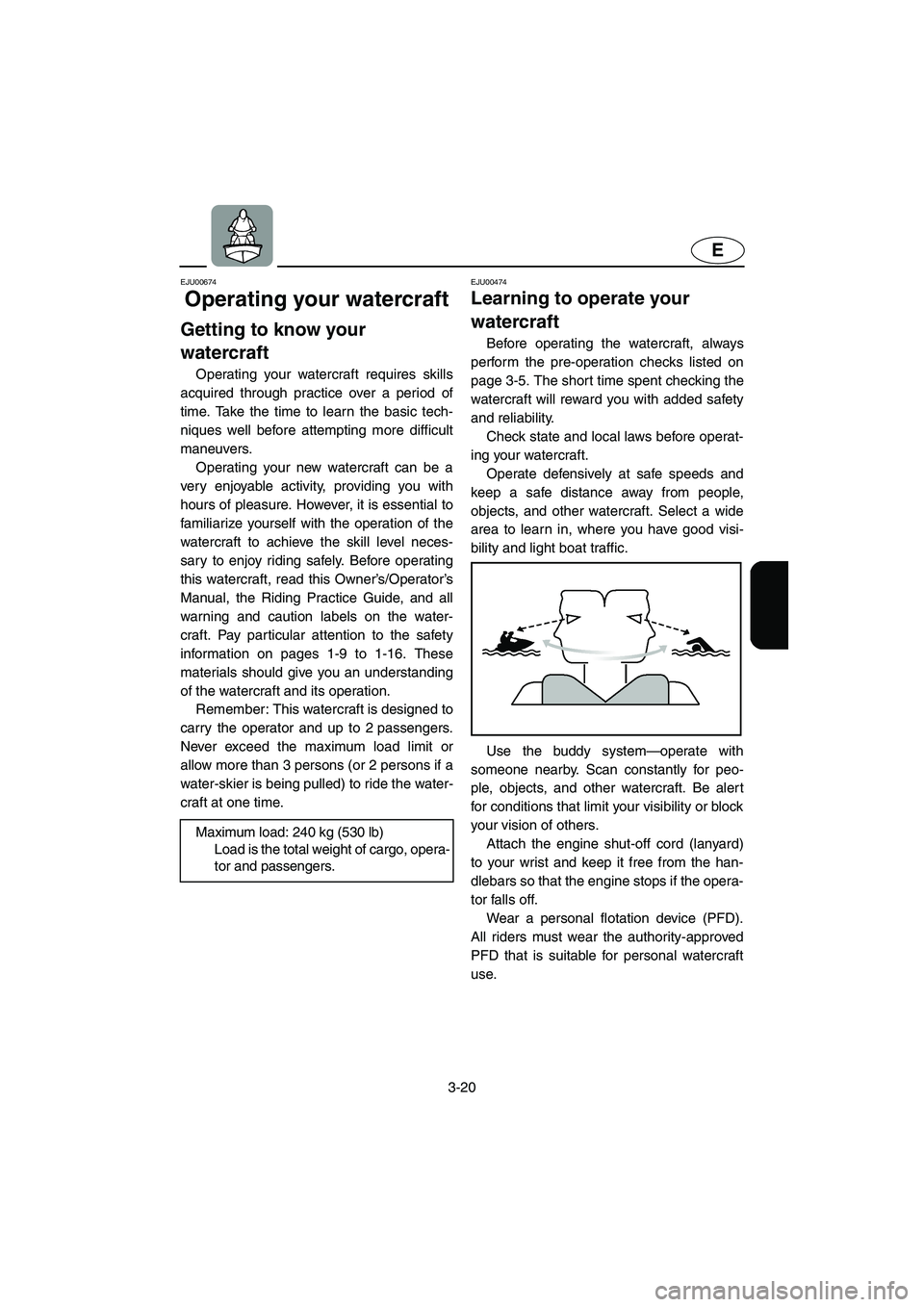
3-20
E
EJU00674
Operating your watercraft
Getting to know your
watercraft
Operating your watercraft requires skills
acquired through practice over a period of
time. Take the time to learn the basic tech-
niques well before attempting more difficult
maneuvers.
Operating your new watercraft can be a
very enjoyable activity, providing you with
hours of pleasure. However, it is essential to
familiarize yourself with the operation of the
watercraft to achieve the skill level neces-
sary to enjoy riding safely. Before operating
this watercraft, read this Owner’s/Operator’s
Manual, the Riding Practice Guide, and all
warning and caution labels on the water-
craft. Pay particular attention to the safety
information on pages 1-9 to 1-16. These
materials should give you an understanding
of the watercraft and its operation.
Remember: This watercraft is designed to
carry the operator and up to 2 passengers.
Never exceed the maximum load limit or
allow more than 3 persons (or 2 persons if a
water-skier is being pulled) to ride the water-
craft at one time.
EJU00474
Learning to operate your
watercraft
Before operating the watercraft, always
perform the pre-operation checks listed on
page 3-5. The short time spent checking the
watercraft will reward you with added safety
and reliability.
Check state and local laws before operat-
ing your watercraft.
Operate defensively at safe speeds and
keep a safe distance away from people,
objects, and other watercraft. Select a wide
area to learn in, where you have good visi-
bility and light boat traffic.
Use the buddy system—operate with
someone nearby. Scan constantly for peo-
ple, objects, and other watercraft. Be alert
for conditions that limit your visibility or block
your vision of others.
Attach the engine shut-off cord (lanyard)
to your wrist and keep it free from the han-
dlebars so that the engine stops if the opera-
tor falls off.
Wear a personal flotation device (PFD).
All riders must wear the authority-approved
PFD that is suitable for personal watercraft
use. Maximum load: 240 kg (530 lb)
Load is the total weight of cargo, opera-
tor and passengers.
E_F0P71-3.fm Page 20 Tuesday, July 18, 2000 7:16 PM
Page 78 of 131
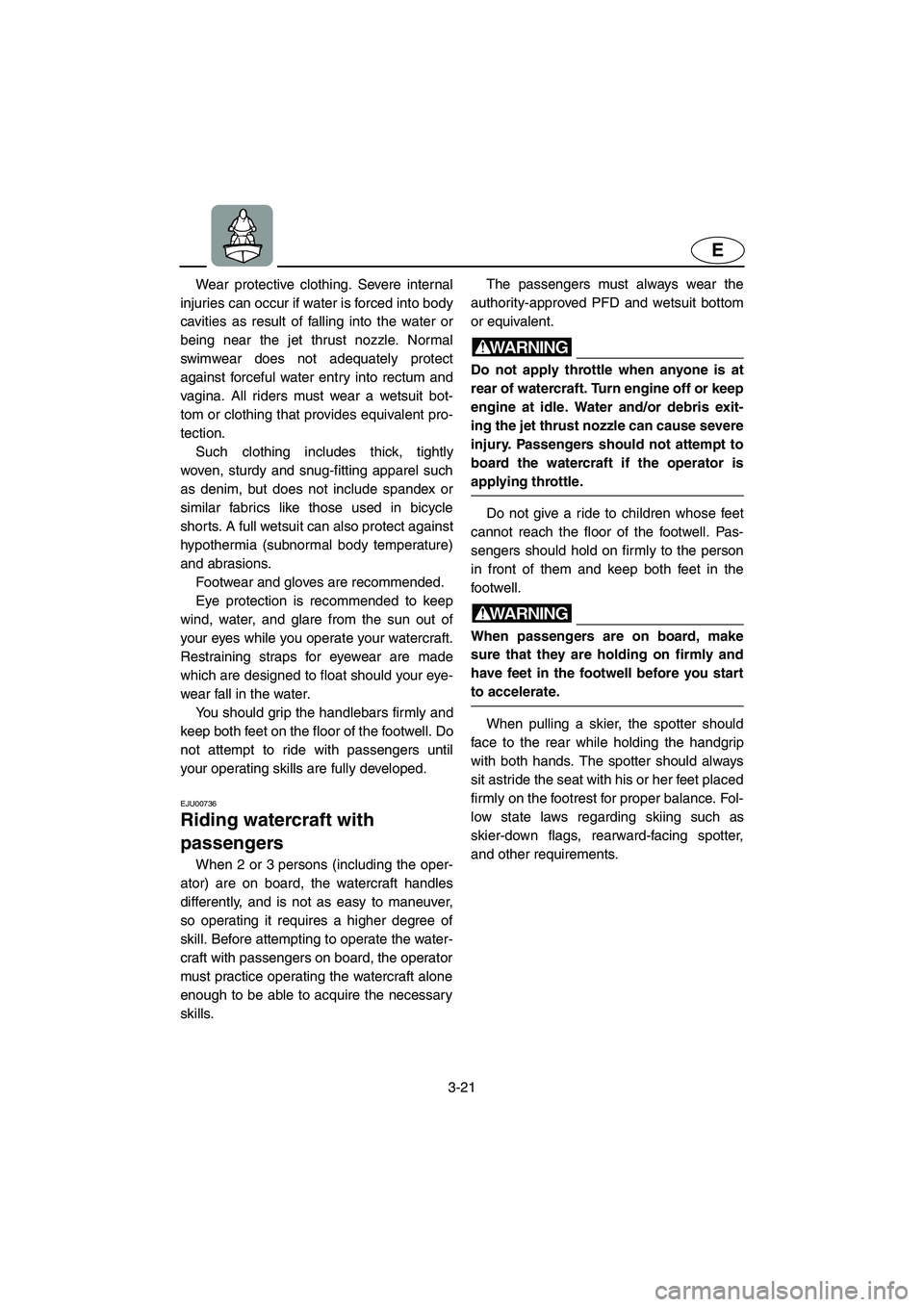
3-21
E
Wear protective clothing. Severe internal
injuries can occur if water is forced into body
cavities as result of falling into the water or
being near the jet thrust nozzle. Normal
swimwear does not adequately protect
against forceful water entry into rectum and
vagina. All riders must wear a wetsuit bot-
tom or clothing that provides equivalent pro-
tection.
Such clothing includes thick, tightly
woven, sturdy and snug-fitting apparel such
as denim, but does not include spandex or
similar fabrics like those used in bicycle
shorts. A full wetsuit can also protect against
hypothermia (subnormal body temperature)
and abrasions.
Footwear and gloves are recommended.
Eye protection is recommended to keep
wind, water, and glare from the sun out of
your eyes while you operate your watercraft.
Restraining straps for eyewear are made
which are designed to float should your eye-
wear fall in the water.
You should grip the handlebars firmly and
keep both feet on the floor of the footwell. Do
not attempt to ride with passengers until
your operating skills are fully developed.
EJU00736
Riding watercraft with
passengers
When 2 or 3 persons (including the oper-
ator) are on board, the watercraft handles
differently, and is not as easy to maneuver,
so operating it requires a higher degree of
skill. Before attempting to operate the water-
craft with passengers on board, the operator
must practice operating the watercraft alone
enough to be able to acquire the necessary
skills.The passengers must always wear the
authority-approved PFD and wetsuit bottom
or equivalent.
WARNING
Do not apply throttle when anyone is at
rear of watercraft. Turn engine off or keep
engine at idle. Water and/or debris exit-
ing the jet thrust nozzle can cause severe
injury. Passengers should not attempt to
board the watercraft if the operator is
applying throttle.
Do not give a ride to children whose feet
cannot reach the floor of the footwell. Pas-
sengers should hold on firmly to the person
in front of them and keep both feet in the
footwell.
WARNING
When passengers are on board, make
sure that they are holding on firmly and
have feet in the footwell before you start
to accelerate.
When pulling a skier, the spotter should
face to the rear while holding the handgrip
with both hands. The spotter should always
sit astride the seat with his or her feet placed
firmly on the footrest for proper balance. Fol-
low state laws regarding skiing such as
skier-down flags, rearward-facing spotter,
and other requirements.
E_F0P71-3.fm Page 21 Tuesday, July 18, 2000 7:16 PM